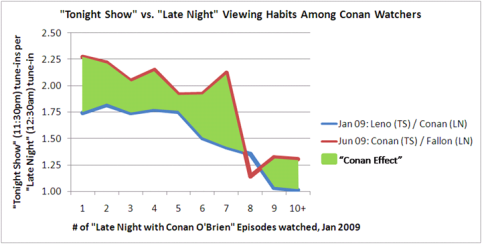Simulmedia - Program Loyalty vs. Daypart Loyalty Among Fans of Conan O'Brien - Stewart Hauser - MediaBizBlogger

Conan O'Brien was recently promoted on NBC from "Late Night" at 12:37am to "The Tonight Show" at 11:35pm, taking over for Jay Leno and leaving a "Late Night" void that has been filled by Jimmy Fallon. This programming switch gives us a unique opportunity to investigate program loyalty vs. daypart loyalty in our quest to better understand viewing habits.

"The Tonight Show" always outdraws "Late Night," but has done so by an even greater margin than normal following Conan's move from 12:30am to 11:30pm. Call it the "Conan Effect." Conan fans watched an additional 0.5 episodes of "The Tonight Show" per episode of "Late Night" following the programming change.
The concept of loyalty clearly plays a role in viewing habits. Genre, program, daypart, and network loyalties, among others, all affect how viewers choose their programs. The Conan case allows us to isolate program and daypart loyalty and investigate which one plays a more important role in viewing habits.
We first located people who had watched "Late Night with Conan O'Brien" in January 2009 (the last full month of the program) and then segmented these viewers based on frequency of viewing the program. We then looked at the viewing habits of these specific segments across three different programs: "The Tonight Show with Jay Leno" in January 2009, "The Tonight Show with Conan O'Brien" in June 2009 (the first month of the show), and "Late Night with Jimmy Fallon" in June 2009.
"The Tonight Show" consistently outdraws "Late Night," since "The Tonight Show" is at a more desirable hour and generally has a more popular host. The y-axis of the graph shows "The Tonight Show" tune-ins per "Late Night" tune-in. All values are greater than 1, since nearly any segment of viewers will watch more than one episode of the 11:30pm show for each episode watched of the 12:30am show.
The graph further demonstrates, however, that the preference for "The Tonight Show" over "Late Night" became even more extreme following the programming change. The green "Conan Effect" area shows that following Conan's move to 11:30pm, the different segments watched an additional 0.5 episodes of "The Tonight Show" for each episode of "Late Night." This area is delineated by two lines: the blue line, which shows that the different segments watched between 1.75 times and 1.1 times more Leno than Conan in January, and the red line, which shows that these same audiences watched between 2.25 times and 1.25 times more Conan than Fallon in June.
The red line is consistently higher than the blue line (except for one specific loyalty group with a small sample size), indicating that the preference for "The Tonight Show" over "Late Night" became more extreme in June compared to January. This difference is statistically significant, as the 95% confidence interval for the difference between the two lines does not contain zero (which would indicate no difference).

For the NBC Late Fringe audience, program loyalty seems to matter more than daypart loyalty. A preference for Conan (or perhaps a dislike of Jimmy Fallon) caused viewers to shift their television consumption across time toward the program that they liked the most. In June, they watched an additional half-episode of "The Tonight Show" for each episode of "Late Night," compared to their viewing pattern in January.
Our goal is to drive viewership through data-driven promotions, and we feel that a better understanding of our viewers will improve our targeting and response rates. The Conan case is just one example, but further study could validate the program vs. daypart conclusion and suggest new directions of study. Perhaps we can reach an audience more efficiently and cost-effectively by placing spots on popular shows during off-peak hours, rather than on primetime shows for which the audience hasn't shown much interest. We could also try to separate program loyalists from daypart loyalists, which would help guide the appropriate promos to show to each group. Viewers are pulled by various forces when choosing a program, and clearly a preference for certain programs plays a strong role, perhaps even stronger than the show's time of day.
Stewart can be reached at stewart@simulmedia.com.
Read all Stewart’s MediaBizBlogger commentaries at Simulmedia - MediaBizBlogger.


